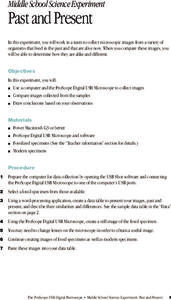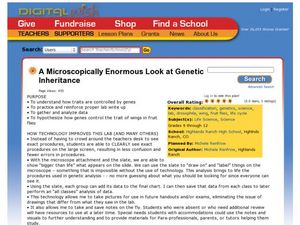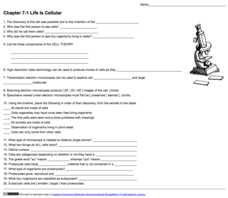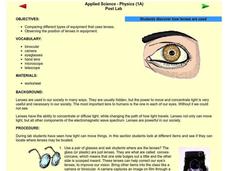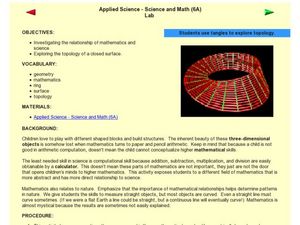Curated OER
Cell Structure
Your accelerated biology learners will add to their understanding of cell structure with this resource. Taking them beyond the basics of mitochondria and chromatin, it also queries them about actin microfilaments and the extracellular...
Curated OER
Science Jeopardy
Wow! Review an entire semester of biology curriculum playing this Science Jeopardy game! The variety of topics is extremely broad, so you will need to review each question to find if they all apply to your course. As you find material...
Curated OER
Past and Present
Students compare fossilized specimens to contemporary specimens. They use a computer and a Proscope Digital USB Microscope to collect and compare images of ferns, sand dollars and sow bugs to those of similar fossilized samples.
Curated OER
Microscope Mania
Students examine parts of a microscope and how to use a microscope at five lab stations. They identify parts of a microscope by describing the differences between low power and high power. They visit Internet sites (included in the...
Curated OER
The Cell
Twenty-three cellular structures are listed for cell biology superstars to write about. They also use their critical thinking caps to explain differences between microscopes and to compare prokaryotic and eukaryotic cells. Use this...
Curated OER
Microscopy
In this microscope worksheet, students complete 15 review questions of labeling, defining and short answer after finishing a compound microscope lab. Lab included.
Curated OER
Plant and Animal Cells - Are they Different?
High schoolers observe the similarities and differences between plant and animal cells. In this cell activity, students use microscopes to observe self prepared slides of animal and plant cells.
Curated OER
I Breath What? Activity-Pollution Detector Worksheet
In this pollution worksheet, learners collect particles using a pollution detector and then observe their results under the microscope. They calculate the average number of particles collected in three different locations. They...
Curated OER
A Microscopically Enormous Look at Genetic Inheritance
Students use microscopes to examine fly families and analyze their genetic inheritance. In this genes lesson plan, students also use the chi square for comparing genes and compare the class results as a whole.
Curated OER
Capturing Bacteria Growth
Young scholars grow bacteria. In this bacteria growth lesson, students allow bacteris to incubate for 2-3 days. The teacher uses a document camera to show how to remove the bacteria from the plate. Young scholars remove a small sample of...
Curated OER
18th Century Microscope
Students examine a microscope from the 18th century. For this microscope lesson, students investigate how it works, what it was used for and how the tool has evolved through the years. Students also build knowledge on how compound...
Curated OER
Examining Pond Life
Students collect and examine microscopic life from a local pond. In this biology lesson, students examine local pond water, searching for protozoa, with the use of a microscope. Students identify the various life forms in their slides...
Curated OER
The Virtual Electron Microscope
Students explore the world of the very small using a Flash plug-in Virtual Electron Microscope. They complete and discuss an activity in which unknown samples are placed under the computer simulated microscope to determine where the...
Curated OER
Magnificent Microscopes
Students use a microscope in a series of activities that are designed to help them explore the "invisible world" and make meaningful microscopic discoveries and learn the importance of the microscope as a tool in science and research.
Curated OER
Discovering Mitosis in Onion Roots
Students discover the different stages of mitosis by examining onion roots under a microscope, drawing diagrams of what they see, and organizing collected data in a chart and create a pie graph from their lab data.
Biology Corner
Life is Cellular
For this cells learning exercise, students answer questions about the first person to see a cell as well as the evolution of microscopes. They define the parts of a cell and tell the differences between Prokaryotes and Eukaryotes. There...
Curated OER
Rotting Food
Students put bread out on a plate for a few days and put it under a microscope when it begins to mold. In this rotting food lesson plan, students discuss eating old food and what it does to your body.
Curated OER
Introduction to Biology
Students participate in a variety of activities to introduce them to biology. In this biology lesson plan, students use microscopes, discover bacteria, view human anatomy, and more.
Curated OER
Lenses
Students explore vision by experimenting with lenses in equipment. In this optics lesson plan, students define the different technology that enhances vision such as microscopes, telescopes and cameras. Students experiment with these...
Curated OER
Exploring Magnification and the Micro-world
Learners examine what magnification is and does. For this microscope and magnification lesson, students listen to a reading of Greg's Microscope by Millicent E. Selson which explains what a microscope does. They talk about magnification...
Curated OER
Applied Science-Science and Math Lab
Students explore magnification. In this scientific observation skills lesson, students observe sea life items and draw pictures of what they observe. Students predict which lens will have the strongest magnification when given three...
Curated OER
Just Because You Cannot See It... Doesn't Mean It's Not There
Young scholars discover bacteria which is around them by using agar over three days. In this biology instructional activity, students predict what they will see over the three days and then take photographs of what is actually shown....
Curated OER
Waterworks
Students investigate the water quality of a river. In this water quality lesson plan, students use microscopes, probing devices, and global positioning systems to determine water quality and create presentations on it.
Curated OER
Microscopes
In this microscopes worksheet, 7th graders read information about microscopes and how they work. Students then complete several questions about the passage. Students study the diagram of a microscope using the letter definitions.




